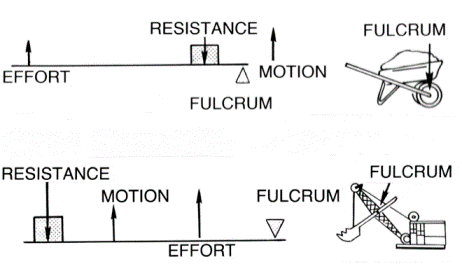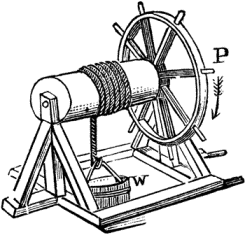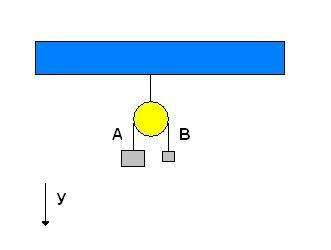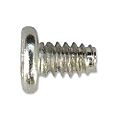Simple Machines
Simple Machines are basic mechanical devices for applying a force and doing work. More complex machines are made up of a bunch of simple machines.
There are 6 basic types of simple machines:
Lever
The lever is made up of a straight rigid object like a board or a bar which pivots on a turning point called a fulcrum. Levers make work easier by using leverage which multiplies the force. When you use a lever, you move a smaller force a longer distance in order to lift a load a short distance. Examples of levers include a seesaw, pliers, crowbars, and tweezers.

See the above pictures for examples of how a lever is used in a wheelbarrow and construction equipment.
Wheel and axle
The wheel and axle is another simple machine. It uses a wheel with a rod attached in the middle as an axle to help it to lift or move loads. In some cases this machine works like a lever to multiply force (like with a doorknob or a fishing reel). In other cases it is used to move objects easier such as with wheels on a bicycle.

Pulley
A pulley is a type of simple machine that uses a wheel with a groove in it and a rope. The rope fits into the groove and one end of the rope goes around the load. You pull on the other end. The pulley helps you to move the load or change direction of the force.

Some examples of pulleys include cranes, flag poles, and window blinds. When multiple pulleys are used together it's called a block and tackle. Another use of the pulley is with a flat wheel and belts. These kinds of pulleys are often used in cars.
Inclined plane
An inclined plane is a flat surface with one end higher than the other. This allows for heavy objects to slide up to a higher point rather than be lifted. It is generally easier to slide something than to lift it.
Examples of inclined planes include slides and ramps.
Wedge
If you put two inclined planes back to back, you get a wedge. A wedge is a simple machine used to push two objects apart.

Examples of the wedge include knives, chisels, and axes.
Screw
A screw is a special kind of inclined plane. It's basically an inclined plane wrapped around a pole. Screws can be used to lift things or to hold them together.

Examples of the screw simple machine include swivel chairs, jar lids, and, of course, screws.
Fun Facts about Simple Machines
Simple Machines are basic mechanical devices for applying a force and doing work. More complex machines are made up of a bunch of simple machines.
There are 6 basic types of simple machines:
Lever
The lever is made up of a straight rigid object like a board or a bar which pivots on a turning point called a fulcrum. Levers make work easier by using leverage which multiplies the force. When you use a lever, you move a smaller force a longer distance in order to lift a load a short distance. Examples of levers include a seesaw, pliers, crowbars, and tweezers.

See the above pictures for examples of how a lever is used in a wheelbarrow and construction equipment.
Wheel and axle
The wheel and axle is another simple machine. It uses a wheel with a rod attached in the middle as an axle to help it to lift or move loads. In some cases this machine works like a lever to multiply force (like with a doorknob or a fishing reel). In other cases it is used to move objects easier such as with wheels on a bicycle.

Pulley
A pulley is a type of simple machine that uses a wheel with a groove in it and a rope. The rope fits into the groove and one end of the rope goes around the load. You pull on the other end. The pulley helps you to move the load or change direction of the force.

Some examples of pulleys include cranes, flag poles, and window blinds. When multiple pulleys are used together it's called a block and tackle. Another use of the pulley is with a flat wheel and belts. These kinds of pulleys are often used in cars.
Inclined plane
An inclined plane is a flat surface with one end higher than the other. This allows for heavy objects to slide up to a higher point rather than be lifted. It is generally easier to slide something than to lift it.
Examples of inclined planes include slides and ramps.
If you put two inclined planes back to back, you get a wedge. A wedge is a simple machine used to push two objects apart.

Examples of the wedge include knives, chisels, and axes.
Screw
A screw is a special kind of inclined plane. It's basically an inclined plane wrapped around a pole. Screws can be used to lift things or to hold them together.

Examples of the screw simple machine include swivel chairs, jar lids, and, of course, screws.
Fun Facts about Simple Machines
- Simple machines were first discovered and described by Greek philosopher Archimedes.
- The Egyptians likely used the inclined plane to help build the pyramids. Using ramps would have made getting the large stones to the top much easier.
- Galileo was the first to work out a working mathematical theory on how simple machines worked.
- Your bicycle makes use of nearly every kind of simple machine in order to make a more complex machine.
- The wheel and axle was an important invention in the history of mankind. It was first used around 5,000 years ago by the Sumerians.